The growing need for production of miniature parts and feature continues to advance as technological and engineering capabilities increase. Medical, dental, mold making, fiber optics, automobiles, and other industries are just a few of the places where micromachining is taking a strong foothold. Such tiny tooling and part features are challenging to manage, and even more so when done at scale. If you are looking for ways to improve productivitiy with micromachining tools, here’s a few tips from the experts at Citrogene.
Understand the Entry Point Angle
Let’s take, for example, a medical device that contain 400 micro holes. If the entry point on the part you are drilling is less than 10 degrees, careful feeding can get the job done. But if the angle is steeper, you’ll need to give the tool some support to prevent the drill from walking across the surface. You can do this by milling a small notch at the entry point, effectively creating a perpendicular starting point for the center drill followed by the drill.
Heat Behaves Differently with Micro Tools
Since the chips that micromachining creates are naturally smaller, less heat is transferred to them, which results in less displacement from the tool and cut. In addition to an oil/air mist to help accelerate cooling and the chip removal, consider using a machine with a fine servo control to peck the hole and fully retract the drill (this is especially useful in high length-to-diameter ratio cuts).
Use the Right Machine for the Job
Avoiding runout and vibration are crucial when it comes to micromachining operations. They are such a high priority for avoidance that there are machines that promote their ability to reduce runout and vibrations. We recommend machines capable of fine feeds and runout well below .0001-inch. And while we also recommend a 30,000 rpm machine or greater, very small holes can be made at around 10,000rpm too, so long as runout is held in check.

Have the Right Skills on Staff
Experienced micromachinists and engineers can turn a micro tool into a seemingly magic wand. They have this almost innate ability to sense when a tool isn’t performing to our high standards. While there is no substitute for experience, these skills are able to learned. At Citrogene, we commit to training our machinists and engineers on all aspects of micromachining in order for us to remain at the top of the industry. If you are interested in joining the team at Citrogene, be sure to check out list of available micromachining jobs and careers.
Build Relationships with Vendors
A craftsman is only as good as his tools. It is important for glass microfabrication manufacturers to maintain excellent relationships with tool vendors and suppliers. When a micromachine needs updating or repairing, it is crucial to find find matching factors like material, web sthickness, and flute count for specific parts. The most minor misalignment in any of these areas can have dramatic impact on the resulting manufactured piece.
Citrogene: Microfabrication Experts in San Jose
Citrogene is the leading partner and manufacturer of micromachined and microfabricated parts. We have experience in working in aerospace, medical devices, automobiles, complex computer components, shadow masks, and much more. To learn more about our capabilities and to submit your design, click here to get started.
